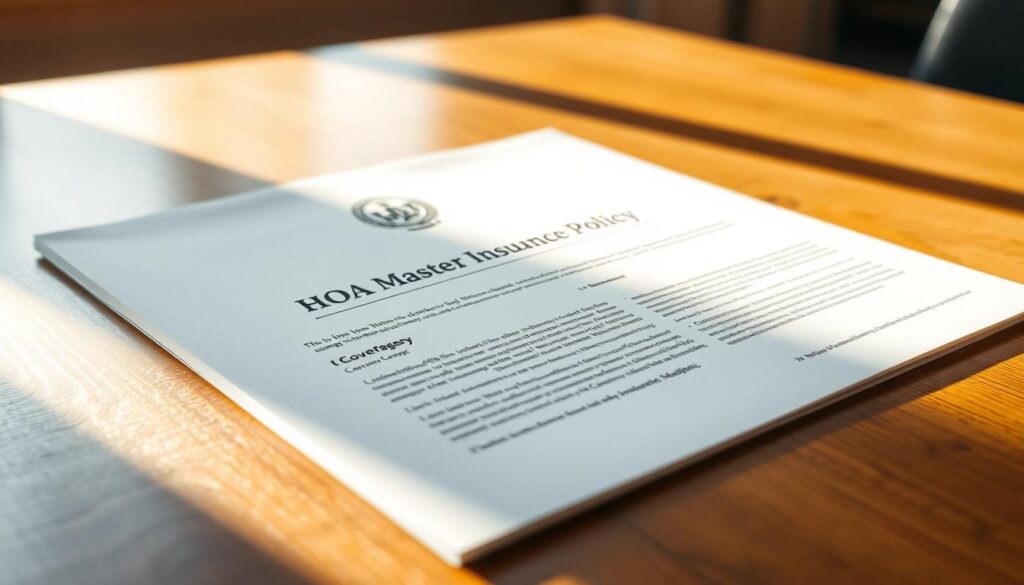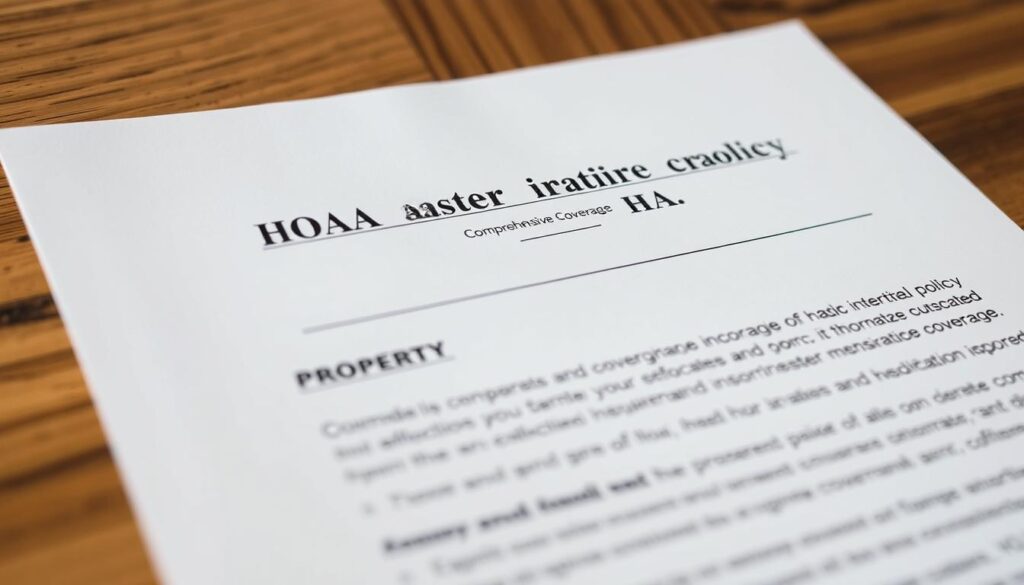As a homeowner in a community with an established HOA or strata, understanding the HOA master insurance policy is crucial for protecting your investment. This policy provides essential coverage for common areas shared within the community, liability coverage for the association, and more.
I will guide you through the importance of having your own copy of this policy to understand what’s covered and what’s not. Having this document is vital for every homeowner to avoid unexpected costs and ensure you have the necessary protection.
Understanding the differences between the HOA’s master insurance policy and your individual homeowner’s insurance is key to having complete protection. I’ll explain why both are necessary and address common misconceptions about what HOA master policies cover.
Key Takeaways
- Understanding your HOA’s master insurance policy is crucial for protecting your investment.
- The policy provides coverage for common areas and liability for the association.
- Having a copy of the policy helps you understand what’s covered and what’s not.
- Both the HOA’s master insurance policy and your individual homeowner’s insurance are necessary for complete protection.
- Misconceptions about HOA master policies can have significant financial implications.
Understanding HOA Master Insurance Policies
Understanding the HOA master insurance policy is vital for homeowners to ensure they are not left with unexpected financial burdens. This policy is a critical component of community management that directly impacts homeowners.
What Is an HOA Master Insurance Policy?
An HOA master insurance policy is a type of insurance coverage that protects the common areas and shared structures within a community. This policy typically coverscondobuildings, amenities, and other shared spaces against various risks. Without this policy, homeowners would have to collectively cover repair costs, legal fees, and settlements, potentially leading to financial strain on the community.

Why This Policy Matters to Homeowners
Homeowners should care about their HOA’s master insurance policy because it affects not only the community’s property values but also their personal financial stability. The policy provides a safety net for catastrophic events, helping to prevent financial ruin for individual homeowners. By understanding the master policy, homeowners can identifygapsin coverage that need to be addressed by their personal insurance. For instance, while the master policy may cover common areas andfixtures, homeowners insurance is necessary to protectpersonal belongings. This understanding enables homeowners to make informed decisions about their insurance needs, ensuring they are adequately protected against potentialrisk.
The Importance of Having Your Own Copy
It’s essential to obtain a copy of your HOA’s master insurance policy to ensure you’re adequately protected. Even though your association’s master insurance is funded by a portion of the fees your association collects, it doesn’t include coverage for your property or belongings. You’ll need individual home insurance for that.

Protecting Your Personal Property
Some associations require member-owners to maintain a minimum amount of insurance on their homes. They often require members to provide a certificate of insurance and renew it annually to prove they’re insured to the association’s standards. Having your own copy of the policy allows you to understand what’s covered and what’s not, ensuring you can make informed decisions about your personal coverage.
Identifying Coverage Gaps
There are often gaps between what’s covered by the HOA’s master policy and your personal insurance policy. For instance, different types of master policies (bare walls, single entity, all-inclusive) create different gaps that need to be addressed. By having your own copy of the policy, you can work with your personal insurance agent to ensure comprehensive coverage and avoid potential financial loss.
Types of HOA Master Insurance Policies
HOA master insurance policies come in various forms, each offering different levels of coverage. Understanding these differences is crucial for homeowners to manage their financial risks effectively.
Bare Walls Coverage
Bare Walls Coverage is a type of HOA master insurance that covers the basic structure of the building, including the walls, roof, and foundation. This type of coverage typically leaves the responsibility for interior elements, such as fixtures and finishes, to the individual homeowners. As a result, homeowners may need to secure additional insurance to protect their personal property and interior upgrades.
Single Entity Coverage
Single Entity Coverage is another form of master insurance that treats the entire building as a single entity. This type of coverage usually includes the original fixtures and finishes as provided by the developer. Homeowners may still need to consider additional insurance coverage for upgrades or customizations made to their units.
All-Inclusive or All-In Coverage
An All-Inclusive Policy, sometimes called an “All-In” Policy, covers almost everything — shared building features, original interior elements, and even your unit’s upgrades or customizations. It’s the most comprehensive type of HOA master insurance policy and leaves fewer gaps for you to worry about. For instance, imagine a small electrical fire damages your unit. Under All-In Coverage, the HOA’s insurance would take care of the walls, built-in features, and even those upgraded hardwood floors or fancy faucets you added after moving in.

As noted by industry experts, “All-Inclusive coverage is considered the gold standard of HOA master policies because it provides the most comprehensive protection for homeowners.” This comprehensive coverage not only protects the building and original fixtures but also covers homeowner upgrades and customizations, reducing the likelihood of coverage gaps.
While All-In Coverage is more comprehensive, it typically results in higher HOA fees. However, it potentially lowers personal insurance costs, as there are fewer gaps in coverage. It’s essential to note that even with this comprehensive coverage, personal belongings are still not covered and require separate insurance.
What These Policies Typically Cover
Your HOA’s master insurance policy is more than just a document; it’s a safeguard against unforeseen damages and liabilities. Understanding what this policy covers is crucial for homeowners, especially in communities prone to natural disasters or with extensive common areas.

Property Coverage for Common Areas
The master policy typically covers common areas such as clubhouses, swimming pools, and landscaping. This coverage includes damage from various events like vandalism or accidental destruction. For instance, if a storm damages the community’s gazebo, the insurance policy should cover the repairs. It’s essential to review the policy to understand the extent of this coverage and any exclusions that may apply.
Liability Coverage
Liability coverage is another critical component of the HOA’s insurance policy. It protects the association and its members from lawsuits related to accidents or injuries in common areas. For example, if a homeowner slips on a patch of ice in the community parking lot, liability coverage could help cover medical expenses or legal fees. Understanding the limits of this coverage is vital for homeowners.
Disaster Coverage and Limitations
For those living in regions prone to natural disasters like hurricanes, earthquakes, or floods, the master policy might include coverage for these events. However, it’s crucial to verify that disaster-specific coverage is included, as it’s not always automatically part of the policy. Homeowners should be aware that deductibles for disaster coverage can be significantly higher than for other claims. Reviewing the policy annually is essential, especially in high-risk areas where insurance requirements may change.
In conclusion, understanding the hoa master insurance policy is vital for homeowners to manage their risk effectively. By knowing what is covered and what is not, homeowners can make informed decisions about their own insurance needs and avoid potential financial pitfalls.
How to Get a Copy of HOA Master Insurance Policy

The key to managing your financial risk as a homeowner lies in obtaining and understanding your HOA’s master insurance policy. This document outlines the coverage for common areas and potentially impacts your liability and financial responsibilities.
Contacting Your HOA Board or Management
The first step in obtaining a copy of the HOA master insurance policy is to contact your HOA board or management company. They are responsible for maintaining the policy and should be able to provide you with the necessary information. When you reach out, be clear about your request and ensure you understand their process for handling such inquiries.
It’s essential to document your request, including the date and method of your inquiry, to ensure there’s a record of your efforts.
Making a Formal Request
If your initial contact does not yield the desired results, you may need to make a formal request. This can involve submitting a written request to the HOA board or management company. Be sure to reference any relevant state laws or HOA governing documents that require the provision of this information to homeowners.
Your request should be clear and concise, specifying the policy you are requesting and the purpose of your inquiry.
What to Do If Your Request Is Denied
If your request for the HOA master insurance policy is denied or ignored, you should escalate the matter. Review your state’s laws regarding HOA disclosure requirements and consider referencing them in your follow-up communications. If necessary, you may need to contact state regulatory agencies or consult with an attorney specializing in HOA law.
Remember, persistent denial of access to this information could be a red flag indicating other governance issues within the HOA.
Reading and Understanding Your Policy
To ensure you’re adequately protected, it’s vital to comprehend the details of your HOA’s master insurance policy. This document outlines the coverage for your condo association‘s common areas and the responsibilities of the association.

Deciphering Insurance Terminology
Insurance policies use specialized language that can be confusing. Deciphering insurance terminology is crucial to understanding your HOA’s master policy. Terms like “deductible,” “coverage limits,” and “waiver of subrogation” are key to grasping the policy’s implications.
- Understand the definitions of key insurance terms
- Familiarize yourself with the policy’s structure and content
- Identify sections that pertain to your responsibilities and coverage
Identifying Coverage Limits and Deductibles
Coverage limits and deductibles are critical components of your HOA’s master insurance policy. Understanding these elements helps you know what is covered and to what extent. The policy will outline the maximum amount the insurance company will pay for a claim and the amount you must pay out-of-pocket.
Reviewing the master policy for coverage limits and deductibles ensures you’re prepared in case of damage or loss.
Understanding Waivers of Subrogation
A waiver of subrogation is a clause in many HOA and COA master insurance policies. This clause prevents the insurance company from seeking to recoup losses by suing the third party responsible for the damage. It helps prevent disputes and litigation among unit owners and the association after a loss.
However, damage or loss caused by gross negligence or illegal activities usually negates a waiver of subrogation. Understanding this clause is crucial for managing expectations in case of a claim or case.
Conclusion
The key to ensuring you’re adequately protected lies in understanding the intricacies of your HOA’s master insurance policy. As a homeowner in an HOA community, it’s vital to obtain a copy of this document and review it annually or whenever changes are made.
Understanding your HOA’s master policy and bylaws is crucial for determining the right insurance coverage for your situation. You should contact your building management or board to clarify the association’s responsibility in the event of an insurance claim and your responsibilities as a unit owner.
To protect your financial interests, it’s essential to identify coverage gaps and ensure your personal insurance policy complements the HOA’s master policy. Reviewing the different types of policies and what they typically cover will help you understand your specific situation within the community.
By taking the time to understand your HOA’s master insurance policy and working closely with your personal insurance agent, you can ensure comprehensive protection and avoid potential financial hardship in the event of a claim. This proactive approach is an essential part of being a responsible homeowner in an HOA community, ultimately saving you from significant stress and insurance costs down the line.
